InterGlobe Aviation Bundle
Can IndiGo Maintain Its Dominance in India's Aviation Arena?
The Indian skies are buzzing with competition, and at the forefront is InterGlobe Aviation, better known as IndiGo. This airline has revolutionized air travel with its low-cost model and operational efficiency. But what does the InterGlobe Aviation SWOT Analysis reveal about its ability to stay ahead?
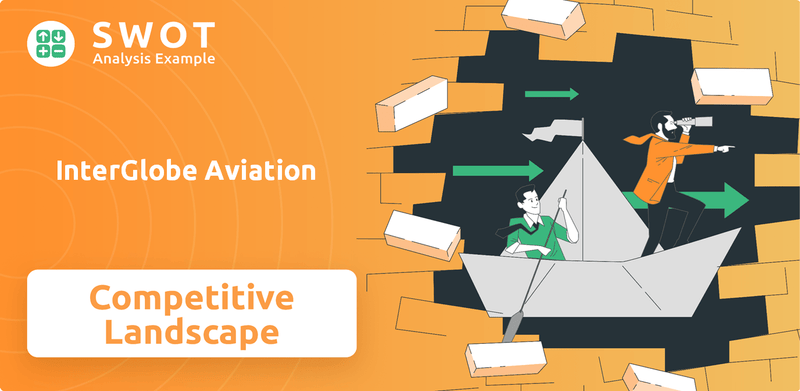
This exploration dives deep into the competitive landscape surrounding IndiGo, examining its primary rivals and the strategies it employs to maintain its market share in the dynamic aviation industry. We'll analyze the forces shaping the airline's future, including market share dynamics, airline competition, and the impact of various factors. Understanding InterGlobe Aviation's market position in 2024 is crucial for anyone looking to navigate the complexities of this sector, from investors to industry analysts.
Where Does InterGlobe Aviation’ Stand in the Current Market?
InterGlobe Aviation, known as IndiGo, is a dominant player in the Indian aviation industry. Its core operations focus on providing affordable and efficient air travel, primarily within India. The airline's value proposition centers on offering cost-effective flights, high punctuality, and extensive route connectivity, catering to a broad customer base.
IndiGo's business model emphasizes high-frequency flights and direct routes to maximize operational efficiency. This approach allows the airline to maintain low operating costs and offer competitive fares. Furthermore, IndiGo has been strategically expanding its international presence, focusing on short-to-medium haul routes to complement its domestic network.
As of February 2025, IndiGo held a significant domestic market share of 60.1%. This demonstrates its strong market position and ability to attract a large customer base. The airline's focus on operational efficiency and cost management has enabled it to maintain profitability and expand its services. For a deeper dive into how IndiGo generates revenue, you can read more about its revenue streams and business model.
IndiGo has consistently maintained its position as the largest passenger airline in India by market share. This dominance is a key indicator of its competitive strength. The airline's ability to capture and retain a significant portion of the market reflects its effective strategies and operational excellence.
In the third quarter of fiscal year 2024 (ending December 31, 2023), InterGlobe Aviation reported a net profit of INR 2,998 crore. This robust financial performance highlights the airline's strong operational efficiency and effective cost management. The financial health of IndiGo is a key factor in its ability to sustain and grow its market position.
IndiGo operates an extensive route network across India, with a growing presence in international markets. Its strategy includes expanding into new regional routes and international destinations. This expansion is crucial for maintaining its competitive edge and catering to a wider customer base.
IndiGo focuses on providing affordable air travel and ensuring punctuality. The airline has also invested in digital transformation to improve customer experience. These initiatives help IndiGo to maintain customer loyalty and attract new passengers.
IndiGo's success in the competitive landscape is attributed to several factors. These include its low-cost structure, efficient operations, and strong brand recognition. Its focus on customer satisfaction and strategic route planning also play a significant role.
- Low-Cost Structure: Enables competitive pricing.
- Operational Efficiency: High aircraft utilization and on-time performance.
- Extensive Route Network: Provides wide connectivity.
- Strong Brand Recognition: Builds customer trust and loyalty.
- Digital Transformation: Improves customer experience and accessibility.
InterGlobe Aviation SWOT Analysis
- Complete SWOT Breakdown
- Fully Customizable
- Editable in Excel & Word
- Professional Formatting
- Investor-Ready Format
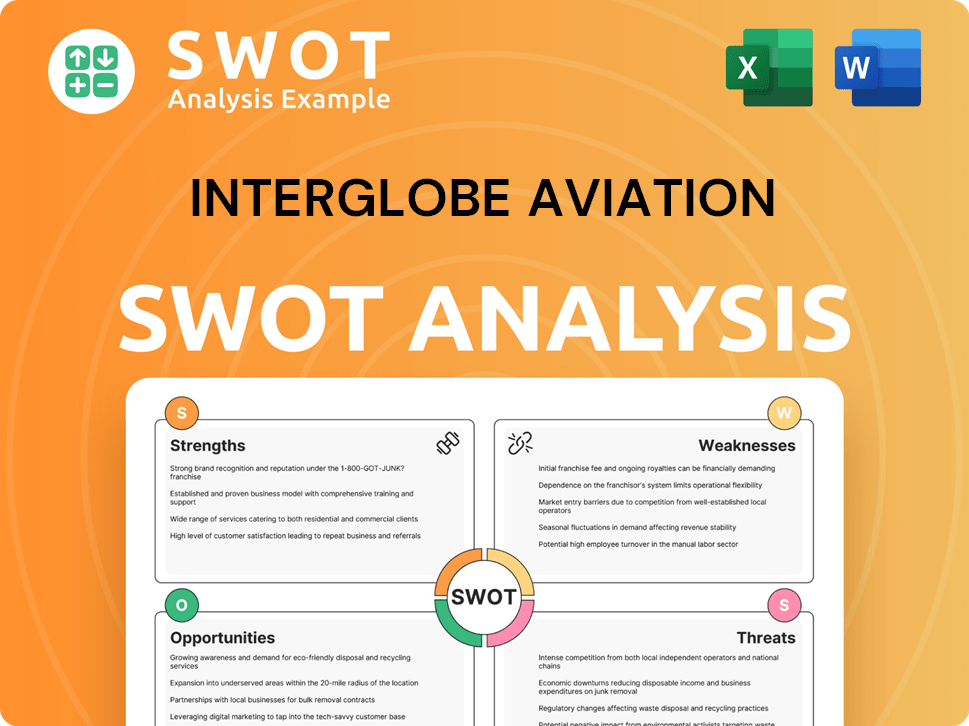
Who Are the Main Competitors Challenging InterGlobe Aviation?
The InterGlobe Aviation (IndiGo) faces a dynamic competitive landscape in both the Indian and international aviation markets. The airline's success is constantly challenged by established and emerging players, requiring strategic adaptation to maintain its market position. Understanding the competitive pressures is crucial for assessing InterGlobe Aviation's future prospects and investment potential.
The aviation industry analysis reveals a complex interplay of factors influencing airline competition, including pricing strategies, route network expansion, and customer service. These elements are key in determining market share in India and the overall financial performance of airlines. The competitive environment necessitates continuous innovation and efficiency improvements to stay ahead.
Recent developments, such as mergers and acquisitions, continue to reshape the competitive dynamics. These changes require a close examination of the strategies and capabilities of key competitors to understand their impact on InterGlobe Aviation.
The primary competitors include Air India (including Vistara and Air India Express), SpiceJet, and Akasa Air. These airlines compete directly with IndiGo on various routes and pricing strategies. Each competitor has its own strengths and weaknesses, influencing their ability to capture market share.
Air India, now under the Tata Group, poses a significant challenge due to its extensive network and financial backing. Air India aims to capture a larger share of both domestic and international traffic. The merger of Vistara into Air India further strengthens its position.
SpiceJet directly competes with IndiGo on price and route networks, although it has faced financial challenges. SpiceJet's ability to maintain competitive fares and expand its network is crucial for its survival. The airline's strategies include route optimization and cost management.
Akasa Air, a relatively new entrant, has rapidly expanded its operations, focusing on efficiency and customer service. Akasa Air's growth strategy includes targeting new and underserved routes. Its success depends on its ability to attract customers and manage operational costs.
Indirect competition comes from other modes of transport, such as Indian Railways and long-distance buses. These alternatives offer cheaper options, particularly for shorter distances. The availability and pricing of these alternatives influence demand for air travel.
Aggressive fare wars and route expansions are common strategies to gain market share. Mergers and alliances are reshaping the competitive landscape. These factors influence the airline's financial performance and strategic decisions.
The competitive analysis of Indigo versus competitors reveals several key strategies. These include pricing, route network optimization, and customer service enhancements. These strategies are crucial for maintaining and increasing market share. For a detailed look at the company, you can read more about InterGlobe Aviation.
- Pricing Strategies: Airlines frequently adjust prices to gain market share, leading to fare wars on popular routes.
- Route Network Expansion: Airlines aggressively expand their route networks to capture new markets and increase connectivity.
- Mergers and Alliances: Mergers and alliances reshape the competitive landscape, creating stronger competitors. For example, the merger of Vistara into Air India.
- Customer Service: Airlines focus on improving customer service to enhance brand loyalty and attract premium customers.
- Cost Management: Efficient cost management is crucial for profitability, especially in a competitive environment.
InterGlobe Aviation PESTLE Analysis
- Covers All 6 PESTLE Categories
- No Research Needed – Save Hours of Work
- Built by Experts, Trusted by Consultants
- Instant Download, Ready to Use
- 100% Editable, Fully Customizable
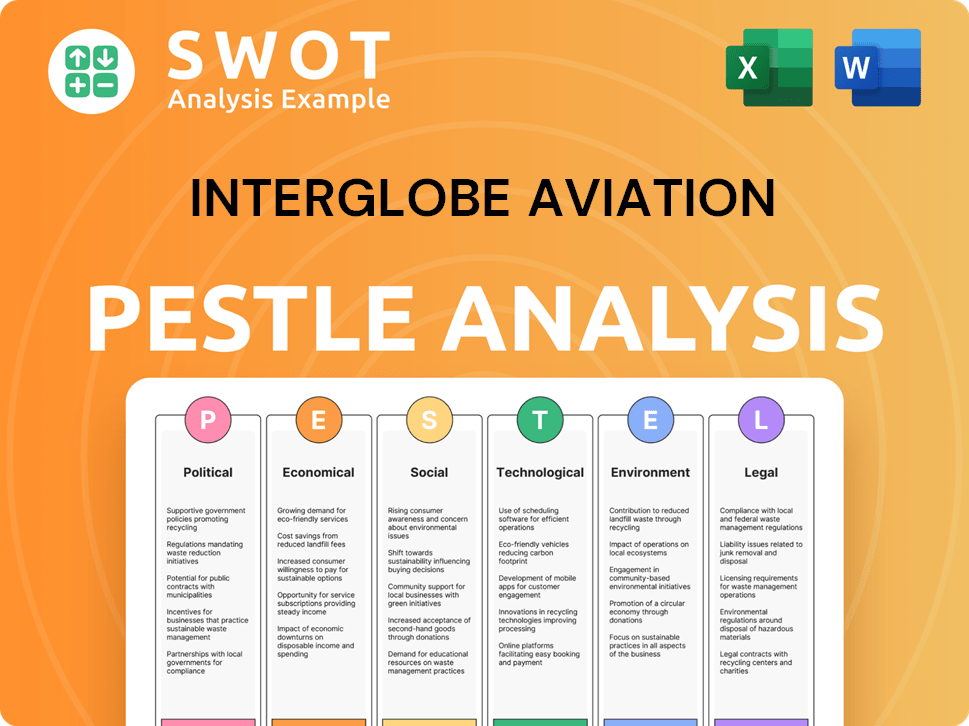
What Gives InterGlobe Aviation a Competitive Edge Over Its Rivals?
The competitive landscape for InterGlobe Aviation, operating as IndiGo, is shaped by its strategic focus and operational efficiencies. IndiGo's success stems from its ability to maintain low operational costs and offer competitive fares, making it a significant player in the aviation industry. Understanding these advantages is crucial for any InterGlobe Aviation's brief history analysis.
IndiGo's market position is further solidified by its extensive domestic network and high flight frequency, providing passengers with greater convenience. The airline's consistent on-time performance also builds customer loyalty. These factors contribute to its strong brand equity and competitive edge in the Indian aviation market.
The airline's financial performance is closely tied to its cost management strategies and operational efficiency. IndiGo's ability to maintain profitability, even amidst fluctuating fuel prices, is a testament to its robust business model and strategic planning. The company's expansion plans and strategies are continuously evolving to meet the demands of the growing aviation market.
IndiGo's focus on a single aircraft type, the Airbus A320 family, results in significant economies of scale. This standardization streamlines maintenance, pilot training, and spare parts management. These efficiencies contribute to lower operational costs and competitive pricing.
IndiGo consistently maintains a high on-time performance record, fostering customer loyalty and trust. This reliability is a key differentiator in the Indian market, where flight delays are a common concern. Its commitment to punctuality enhances its brand reputation.
IndiGo's extensive domestic network and high flight frequency provide passengers with more choices and greater convenience. This is particularly advantageous for business travelers. The airline's route network strategy is designed to maximize market coverage and passenger convenience.
Disciplined cost management, including efficient fuel hedging strategies and optimized crew rostering, contributes to IndiGo's profitability. These strategies allow the airline to offer competitive pricing. This focus on cost control is vital in the competitive aviation industry.
IndiGo's competitive advantages include operational efficiency, on-time performance, an extensive network, and robust cost management. These factors collectively contribute to its strong market position and financial performance. The airline’s ability to maintain these advantages will be crucial for its future outlook.
- Single Aircraft Type: Standardization on the Airbus A320 family reduces maintenance and training costs.
- High On-Time Performance: Consistent punctuality builds customer trust and loyalty.
- Extensive Domestic Network: Provides passengers with more choices and convenience.
- Cost-Effective Operations: Efficient fuel hedging and crew management enhance profitability.
InterGlobe Aviation Business Model Canvas
- Complete 9-Block Business Model Canvas
- Effortlessly Communicate Your Business Strategy
- Investor-Ready BMC Format
- 100% Editable and Customizable
- Clear and Structured Layout
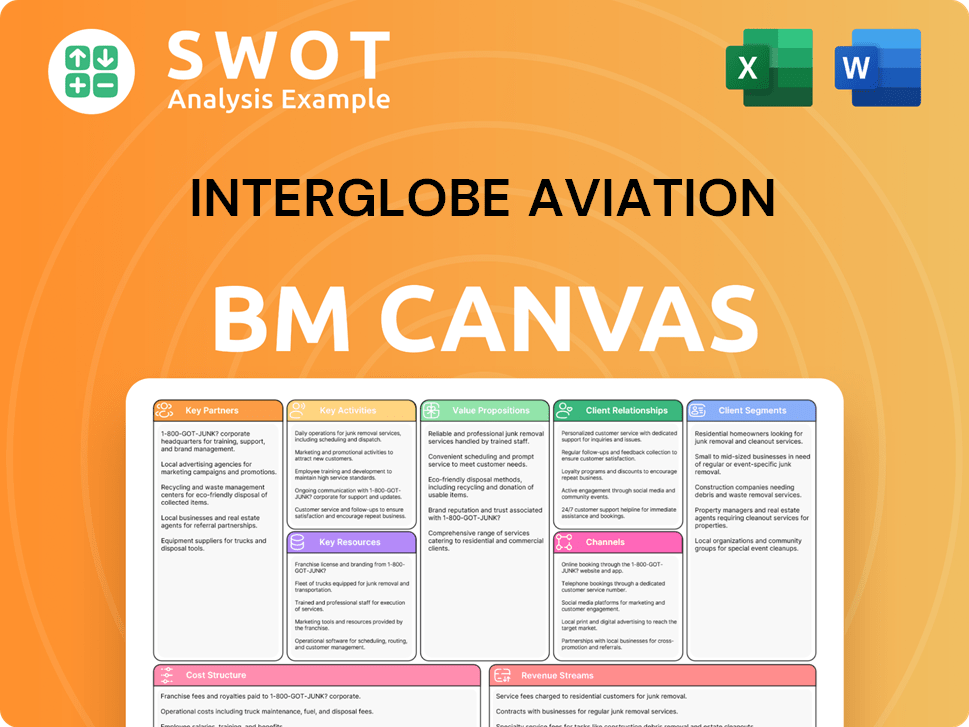
What Industry Trends Are Reshaping InterGlobe Aviation’s Competitive Landscape?
The Indian aviation industry is currently experiencing significant transformation, with InterGlobe Aviation (Indigo Airlines) at the forefront. The airline faces a dynamic competitive landscape, shaped by technological advancements, regulatory changes, and evolving consumer preferences. Understanding the current market dynamics is crucial for assessing the company's future prospects. This analysis provides insights into the industry trends, future challenges, and opportunities for InterGlobe Aviation, offering a comprehensive view of its competitive position.
The aviation sector is characterized by both risks and opportunities. Rising fuel prices, intense competition, and infrastructure constraints pose challenges. However, the growing demand in Tier 2 and Tier 3 cities, coupled with international expansion prospects, presents significant growth avenues. InterGlobe Aviation must navigate these complexities strategically to maintain its market leadership and drive sustainable growth. A detailed Marketing Strategy of InterGlobe Aviation can provide additional insights into their approach.
Technological advancements, like AI and digital interfaces, are transforming airline operations. Regulatory changes, including those related to sustainable aviation fuels, impact costs. Consumer preferences are shifting towards personalized experiences and regional connectivity. These factors influence InterGlobe Aviation's operational strategies.
Potential challenges include new market entrants and aggressive expansion by existing players. Rising fuel prices and infrastructure constraints at major airports also pose risks. Global economic shifts and geopolitical uncertainties can impact international travel demand. These challenges could affect InterGlobe Aviation's profitability.
Significant growth opportunities exist in emerging Tier 2 and Tier 3 cities, experiencing increased air travel demand. Expansion into new international routes and strategic partnerships can boost revenue. InterGlobe Aviation can diversify its network and enhance customer offerings. These opportunities can drive market share gains.
InterGlobe Aviation is likely to evolve towards a more diversified network and increased digital integration. The company will continue to focus on cost leadership. Strategies include enhancing ancillary revenues and exploring new revenue streams. Technology investments will be crucial for maintaining leadership.
In 2024, the Indian aviation market is expected to see continued growth, with passenger traffic projected to increase. InterGlobe Aviation's market share remains dominant, but competition is intensifying.
- Market Share: InterGlobe Aviation holds approximately 58% of the domestic market share as of early 2024.
- Fleet Expansion: The airline continues to expand its fleet, with plans to add new aircraft to meet growing demand.
- Financial Performance: Revenue and profit margins are influenced by fuel prices and operational efficiency.
- Route Network: InterGlobe Aviation is expanding its route network, focusing on both domestic and international destinations.
InterGlobe Aviation Porter's Five Forces Analysis
- Covers All 5 Competitive Forces in Detail
- Structured for Consultants, Students, and Founders
- 100% Editable in Microsoft Word & Excel
- Instant Digital Download – Use Immediately
- Compatible with Mac & PC – Fully Unlocked
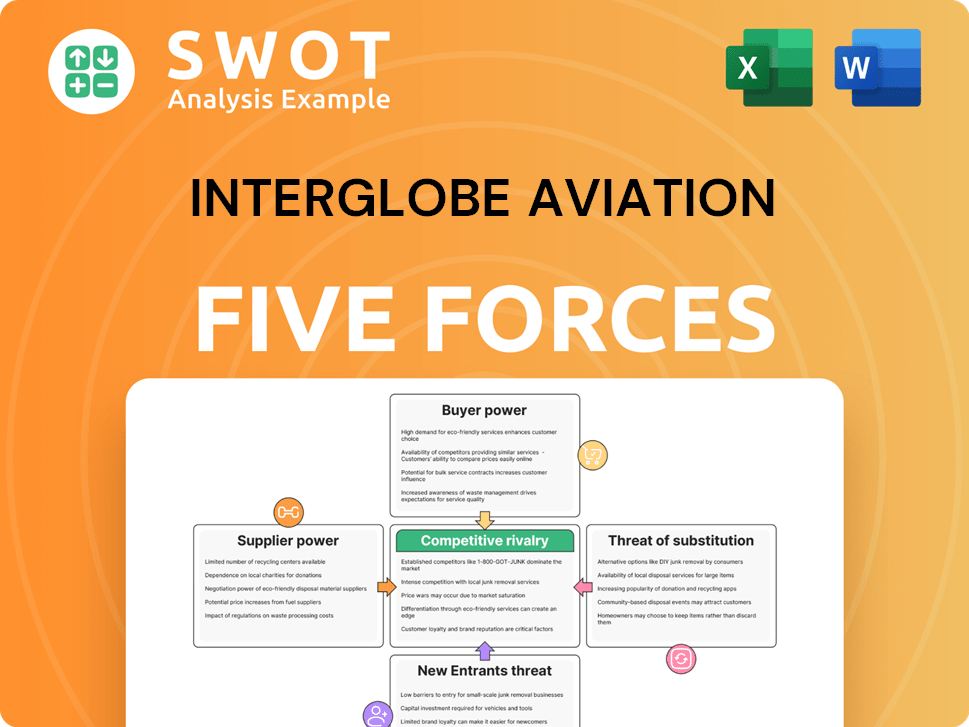
Related Blogs
- What are Mission Vision & Core Values of InterGlobe Aviation Company?
- What is Growth Strategy and Future Prospects of InterGlobe Aviation Company?
- How Does InterGlobe Aviation Company Work?
- What is Sales and Marketing Strategy of InterGlobe Aviation Company?
- What is Brief History of InterGlobe Aviation Company?
- Who Owns InterGlobe Aviation Company?
- What is Customer Demographics and Target Market of InterGlobe Aviation Company?
Disclaimer
All information, articles, and product details provided on this website are for general informational and educational purposes only. We do not claim any ownership over, nor do we intend to infringe upon, any trademarks, copyrights, logos, brand names, or other intellectual property mentioned or depicted on this site. Such intellectual property remains the property of its respective owners, and any references here are made solely for identification or informational purposes, without implying any affiliation, endorsement, or partnership.
We make no representations or warranties, express or implied, regarding the accuracy, completeness, or suitability of any content or products presented. Nothing on this website should be construed as legal, tax, investment, financial, medical, or other professional advice. In addition, no part of this site—including articles or product references—constitutes a solicitation, recommendation, endorsement, advertisement, or offer to buy or sell any securities, franchises, or other financial instruments, particularly in jurisdictions where such activity would be unlawful.
All content is of a general nature and may not address the specific circumstances of any individual or entity. It is not a substitute for professional advice or services. Any actions you take based on the information provided here are strictly at your own risk. You accept full responsibility for any decisions or outcomes arising from your use of this website and agree to release us from any liability in connection with your use of, or reliance upon, the content or products found herein.